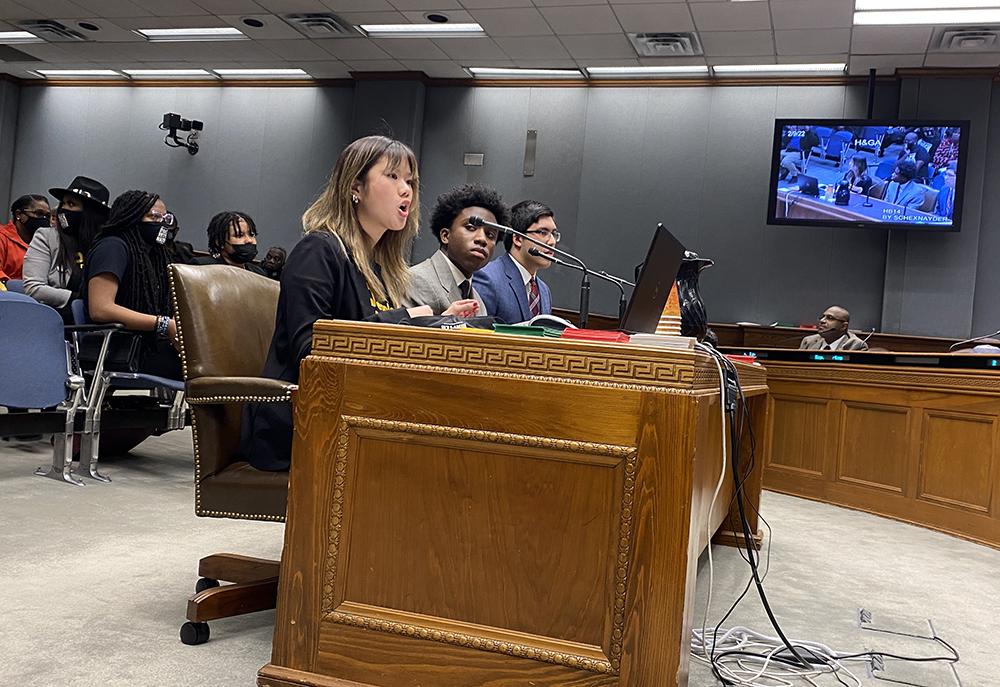Margaret DeLaney, Piper Hutchinson and Allison Kadlubar, LSU Manship School News Service
BATON ROUGE – Sparks flew between lawmakers and high school students at a House redistricting committee hearing in early February.
A group of teenagers trekked from Shreveport, Feb. 9, to testify in front of the powerful House and Governmental Affairs Committee against a Republican redistricting bill that would not increase Black representation in the Louisiana House.
Kingson Wills, Sabrina Huynh and Ryan Wilkinson took the stand together to speak out against what they called racial gerrymandering. They were met with pushback from Rep. John Stefanski, R-Crowley, the chairman of the committee.
Stefanski pursued a tough line of questioning against the trio, first asking them to identify a district on a proposed House map that had been gerrymandered and to tell him where it was.
Wilkinson identified House District 23 as one such district. Under the proposal put forward by House leaders, the Natchitoches-based majority Black district would be broken up and absorbed by mostly white districts nearby to accommodate plans for a new majority-minority district in New Orleans.
Stefanski pushed back on the claim, as his proposal did not still have House District 23 in northwest Louisiana.
“Oh yeah, because y’all gerrymandered it,” Wilkinson retorted.
Stefanski then asked the 18-year-old high school senior to define gerrymandering and to tell him details of the demographics of District 23.
At that point, the majority Black audience began to engage in “call and response,” a common practice in the Black community in which members of a crowd echo a speaker’s sentiments, to protest the teen’s treatment.
Rep. Tanner Magee, R-Houma, who was chairing the committee at the time, intervened to ask the crowd to quiet down. “This is not choir practice,” Magee said. “If it’s going to be disruptive, we will ask members to leave. And then if you keep being disruptive, you will be forced to leave.”
Stefanski later apologized to the high school students for questioning them so harshly. “I apologize if it came off as a little aggressive for you,” Stefanski said. “Sometimes, we get high strung. Sometimes, we get into tense situations.”
Autumn Sommers, another student who testified against the bill, was at the mic for Stefanski’s apology.
“Thank you, Rep. Stefanski,” Sommers said. “Please stop deflecting the questions and trying to interrogate teenagers.”
The committee ended up voting 13-4 to approve the Republican bill, HB14, which would maintain the current total of 29 of the 105 House districts as majority Black. One Democrat, Jeremy LaCombe of New Roads, voted with the Republicans, as did politically independent Rep. Malinda White of Bogalusa, to advance the bill.
Wills, who is co-chair of The People’s Promise Youth Division, an organization started in August 2021 to increase youth advocacy and participation in politics, objected in an interview after the hearing to the way the students were treated by Stefanski.
“He came from a position of power, and as an adult; and thought that we, as a youth, didn’t know what was really happening,” Wills said.
The youth group was one of several civil rights and advocacy organizations participating in a “Redistricting Takeover” at the Capitol on Feb. 9.
A crowd of over 30 activists from across the state held “It’s about us” signs and shouted chants before heading into session.
“What do we want? Fair Maps! When do we want it? Now,” the crowd chanted in between speeches from Black political leaders.
Amid the tensions at the hearing, there was agreement among legislators in both parties about how dedicated Stefanski and his staff have been in speaking and listening to all 105 House members about their preferences.
Sommers, who is co-chair of the youth group, disagreed in an interview. “A lot of people are saying [Stefanski] did his best drawing the maps. If your best map is racist, then I don’t really care,” Sommers said. “You can put your full effort toward something, it doesn’t mean it’s right.”
Wilkinson agreed with Sommer’s assessment. “It’s like if you asked students to grade their own tests,” he said. “If all students failed their tests, but then they graded their own and gave themselves A’s…well, that’s what they’re doing in redistricting,” Wilkinson said.
Rep. Duplessis acknowledged that the process had flaws.
“No matter how well we all try to do individually to serve our districts and to serve the state of Louisiana, the fact that we draw our own district lines is an inherently flawed process,” Duplessis said.

